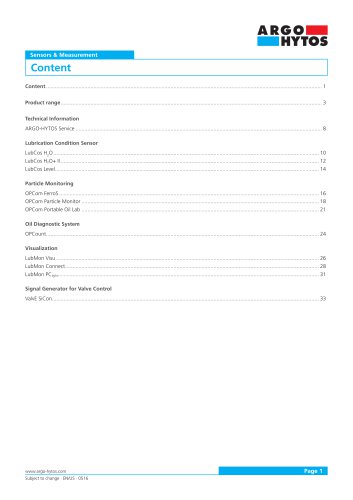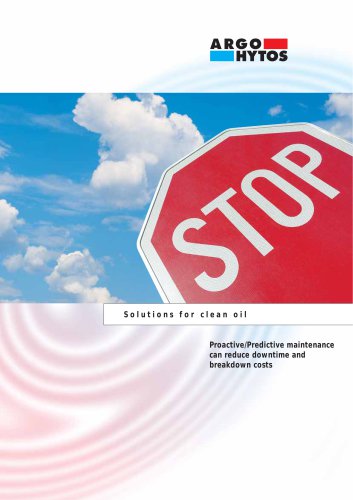
Catalog excerpts

Filter Selection Guideline Tips and information on how to select the optimal hydraulic filter Preface When determining the required cleanliness in a hydraulic system, additionally to the technical requirements of the hydraulic components and to the operating pressure, the user‘s expectations to availibility, safety and service life of a machine become increasingly important. These aspects were particularly taken into account in the present ARGO-HYTOS guideline. Detailed attention is also given to two filter concepts which are becoming increasingly important: return-suction filters and off-line filters. More than ever before, the ARGO-HYTOS Guidelines offer useful advice on selecting technically and economically ideal filter concepts for hydraulic systems, and experts will also find that they contain important information. Did you know that … › fresh oil can often contain 10 times more dirt particles than are acceptable for hydraulic systems of high technical quality? › if the operating pressure is increased by only 50 %, the ARGO-HYTOS Return-Suction Filter E 198 number of dirt particles in the oil must be reduced by a factor of 3 to avoid a deterioration in the lifetime of the components? › even a filtration quotient of β = 200 corresponds to filtration efficiency of 99,5 % for all dirt particles that are larger than the specified size, and a β-value of only 10 still corresponds to 90 % efficiency? › even oil sample bottles declared as clean can contain considerably more dirt particles than the examined oil, if it comes from hydraulic systems with good filtration? › a lifetime of 1.000 service hours for a hydraulic filter corresponds to a mileage of about 60.000 km of a passenger car? › only an online count can determine the actual values for cleanliness classes < 10 (ISO 4406)? www.argo-hytos.com Subject to change
Open the catalog to page 1
Our know-how - your benefit At ARGO-HYTOS, the focus is consistently on the customer – and a major element of our devel pment work is to implement o customer-specific solutions for filters and systems. Continuous improvement of our filter elements is another major goal of our devel pment work: for example, this includes o increasing the dirt capacity while keeping the installed volume as small as possible. This optimization goal is excellently achieved by our range of standard return-suction filters – just one example of many. Our sales engineers are just as eiable as our filters...
Open the catalog to page 2
Quality and safety The key feature of the entire hydraulics sector is that – for understandable reasons – users are setting demanding (and ever increasing) require ents for the quality and efficiency of the m filters that are used. The testing technology used to develop filters must also meet these requirements. And this is where the difference between “filters” and ARGO-HYTOS filters emerges very clearly! ARGO-HYTOS operates testing rigs that are equipped with ultra-modern technology, enabling fast test sequences, extended testing procedures and accurate documentation of all the...
Open the catalog to page 3
Mobile oil analysis The ARGO-HYTOS service vehicle Oil cleanliness requirements are becoming stricter as time goes on. Filters are now expected to offer service lifetimes of 1.000 hours or more. Oils that stay clean not only extend the usual intervals between oil changes – they also prevent faults during operation, and they substantially extend the lifetimes of all the hydraulic components. Only in rare instances do we know how clean or dirty the pressure fluid in a hydraulic system really is. In many cases, the medium is only examined when a failure occurs or when damage is noticed....
Open the catalog to page 4
Guideline on selecting the optimal hydraulic filter The ARGO-HYTOS procedure for selecting a filter The selection procedure described below makes it easy for you to select the right filters for hydraulic systems. To simplify matters, the procedure is broken down into these steps: Suction filters determine the right filter type determine the filter fineness that is needed determine the filter size that is needed other considerations This filter selection procedure is based on many years of practical experience with countless mobile and industrial hydraulic systems that are equipped with...
Open the catalog to page 5
How to determine the proper filter type Suction filters Hydraulic systems have to be fitted with a suction filter if there is a particularly high risk of damage to the pump from coarse contamination (Figure 1). Typical applications of this sort include: › systems with a common oil reservoir for working hydraulics and gear transmissions. › units with oil tanks of large dimensions and/or complex shapes, or those which are welded or casted. Experience shows that 100% cleaning of the tank prior to assembly is impossible under these circumstances. › systems that are filled under difficult...
Open the catalog to page 6
How to determine the proper filter type Return filters It is particularly beneficial to use filters that are mounted on the tank or integrated in it, because this method allows filtering of the entire oil flow (full flow filtration) at low cost and with low space requirements (Figure 1). Full flow filtration in the return flow protects the pumps against dirt which penetrates the system from outside (especially via hydraulic cylinders) or which is generated by abrasion. When selecting the right filter size, it is essential to consider the maximum possible flow rate. Depending on the area...
Open the catalog to page 7
How to determine the proper filter type Return-suction filters ARGO-HYTOS first developed its return suction filters in the mid-1980’s. On equipment with a hydrostatic drive and combined working hydraulics, these filters replace the suction and/or pressure filters that were previously required for the filling pump of the closed hydrostatic drive, and in an open circuit they replace the return filter for the working hydraulics (Figure 1). The benefit of these filters is that filtered oil is fed to the filling pump at an overpressure of 0,5 bar, avoiding the risk of cavitation in the filling...
Open the catalog to page 8All ARGO-HYTOS catalogs and technical brochures
-
MLS3-06
10 Pages
-
C5.3511 · C5.3516 · C5.3529
3 Pages
-
LS 040 · LS 075
6 Pages
-
ES 075
6 Pages
-
Catalogue Hydraulic Drives
65 Pages
-
Catalogue Fluid Management
69 Pages
-
Light Line
4 Pages
-
Off-line Filtration
2 Pages
-
Catalogue Filtration
342 Pages
-
Catalogue Lightline
50 Pages
-
RC series
4 Pages
-
TS3 MTS2
6 Pages
-
TS4 MTS
6 Pages
-
ECOLINE
8 Pages
-
SR4P2-B2
4 Pages
-
SR1P2-A2
4 Pages
-
PRM7-10
10 Pages
-
PRM8-06
4 Pages
-
PRM2-04
20 Pages
-
PRM6-10
20 Pages
-
PRM7-06
10 Pages
-
PRM2-06
20 Pages
-
PRM7-04
10 Pages
-
Coils
18 Pages
-
Datasheet RPEL1-06
6 Pages
-
Datasheet RPH2-06
4 Pages
-
Datasheet RPR3-04
4 Pages
Archived catalogs
-
MDA Highlights 2015
24 Pages
-
Solutions for clean Oil
6 Pages
-
Brochure for Endusers
2 Pages
-
Agritechnica Highlights 2015
32 Pages
-
Brochure Wind Energy
2 Pages
-
EXAPOR MAX 2
3 Pages
-
Guidelines
21 Pages
-
Product summary
16 Pages
-
ARGO-HYTOS program summary
16 Pages
















































